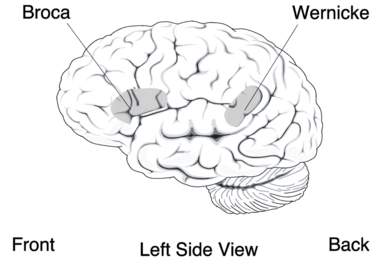Speech–language pathology facts for kids
Quick facts for kids Speech-language pathology |
|
|---|---|

Broca's area (speech production) and Wernicke's area (language comprehension)
|
|
| Specialty | {{#statements:P1995}} |
| MeSH | D013066 |
Speech-language pathology (often called speech therapy) is a healthcare field practiced worldwide. It focuses on helping people with problems related to communication and swallowing.
A professional in this field is called a speech-language pathologist (SLP) or a speech and language therapist (SALT). SLPs are trained at universities. They help people of all ages to speak, understand, and swallow better. They also help diagnose and treat conditions like autism spectrum disorder, often working with doctors and psychologists.
Contents
What Do Speech-Language Pathologists Do?
SLPs help people with many different issues. They assess, diagnose, and treat problems with:
- Communication: This includes speaking, understanding, reading, and writing.
- Thinking Skills: Such as attention, memory, and problem-solving, when these affect communication.
- Voice: Problems like a hoarse voice or a voice that is too soft.
- Swallowing: Difficulties with eating or drinking safely.
These problems can happen for many reasons, like a stroke, brain injury, hearing loss, or conditions like cerebral palsy.
Common Issues SLPs Help With
Many people think SLPs only help with stuttering or pronouncing words. But they do much more! Here are some examples:
- Finding Words: When someone struggles to remember or say the right word.
- Social Communication: How people interact and use language in social situations.
- Grammar: Difficulties building correct sentences or changing word meanings.
- Reading and Writing: Problems with understanding sounds in words (phonics) or the meaning of text.
- Voice Problems: Like a raspy voice or one that is too quiet.
- Thinking and Communication: When memory or attention issues affect how someone communicates.
- Coaching: Teaching parents and caregivers how to better communicate with someone who has difficulties.
How We Speak and Use Language
Speaking involves several parts:
- Making Sounds: Using your voice box (larynx).
- Resonance: How sound vibrates in your nose and mouth.
- Fluency: Speaking smoothly, without breaks or repetitions.
- Intonation and Pitch: The ups and downs in your voice that give meaning.
- Breathing: Using your breath to power your voice.
Language involves:
- Sounds of Language: Knowing how sounds work in a language.
- Word Parts: Understanding how parts of words change their meaning.
- Sentence Structure: Building sentences using grammar rules.
- Meaning: Understanding the meaning of words and symbols.
- Social Rules: Using language correctly in different social settings.
Who Do SLPs Help?
SLPs work with people of all ages, from babies to older adults.
Infants and Children
- Babies who have trouble feeding or swallowing.
- Children with genetic conditions like Down syndrome or cleft palate that affect speech.
- Kids with autism spectrum disorders.
- Children with developmental delays.
- Those with hearing loss.
- Kids who have trouble making specific sounds (like the "r" sound).
- Children who stutter.
- Kids with traumatic brain injury.
In the United States, children can often get speech therapy through public schools. Private therapy is also available, sometimes even online using video calls. In the United Kingdom, children can get assessments and treatment through the NHS.
Children and Adults
SLPs help people of all ages with:
- Speech problems like stuttering.
- Voice disorders.
- Difficulties from head injury or stroke.
- Learning challenges like dyslexia.
- Problems understanding or using language.
- Conditions like cerebral palsy.
Adults
- Adults with swallowing difficulties.
- Those with language problems due to conditions like Alzheimer's disease, Parkinson's disease, or multiple sclerosis.
- People who have had a stroke or brain injury.
- Adults seeking voice training, such as for transgender individuals.
Working Together
SLPs often work with other healthcare professionals. They might team up with:
- Doctors
- Nurses
- Dentists
- Teachers
- Occupational therapists
- Psychologists
- Audiologists (hearing specialists)
For example, children with cleft lip and palate often need help from both surgeons and SLPs to fix speech problems. Working as a team helps the person get the best care.
Where SLPs Work
SLPs work in many different places, including:
- Hospitals (public and private)
- Private clinics
- Nursing homes
- Schools and universities
- Community health centers
- Sometimes even in prisons or youth centers.
Many SLPs work one-on-one with their clients. Some also provide services through video calls, which is called "telepractice."
Becoming an SLP
To become a speech-language pathologist in the United States, you need to go to college for many years.
- First, you earn a bachelor's degree.
- Then, you get a master's degree in speech-language pathology. This program includes many hours of hands-on practice.
- After graduation, you must pass a national exam.
- You also complete a special training period called a "clinical fellowship year" (CFY) under an experienced SLP.
- Finally, you get a license from your state and a national certification.
To keep their license, SLPs must continue learning throughout their careers. They also help train new SLPs and teach families and other professionals about communication and swallowing.
See also
 In Spanish: Terapia del lenguaje para niños
In Spanish: Terapia del lenguaje para niños
- Applied linguistics
- List of voice disorders
- Neurolinguistics
- Speech acquisition
- Speech perception


